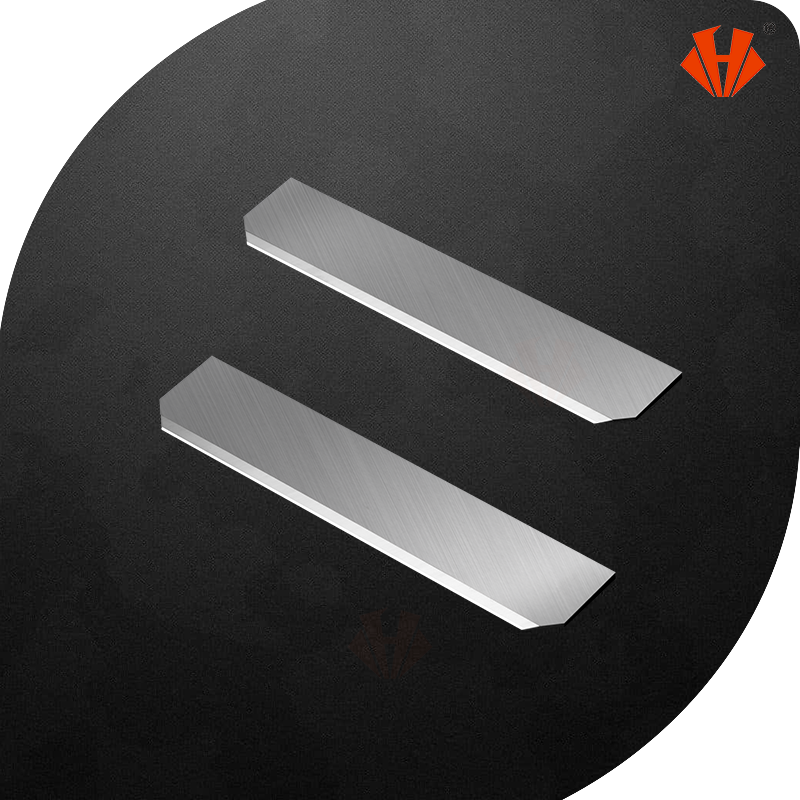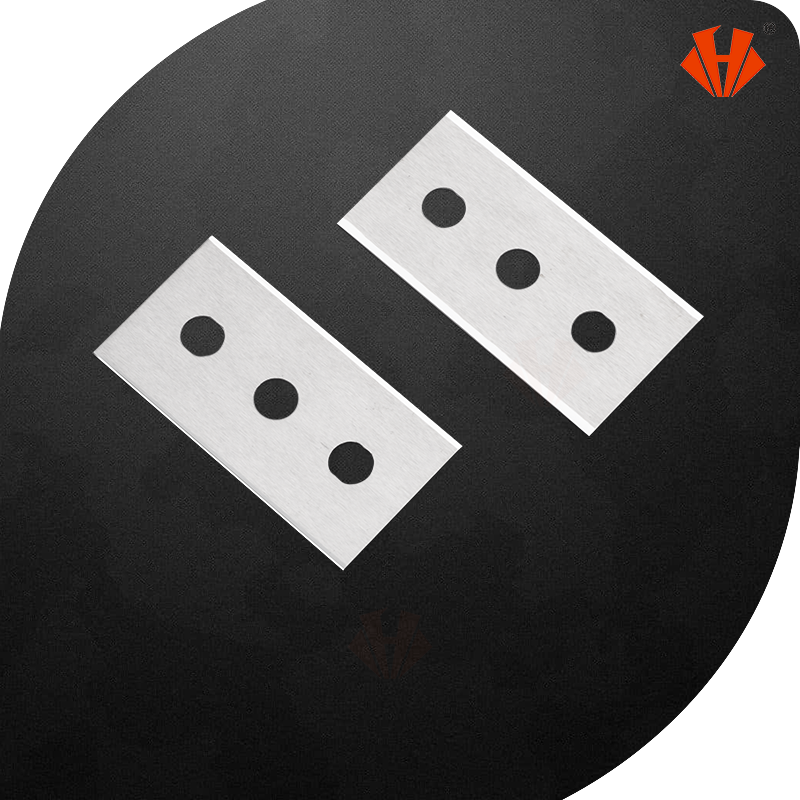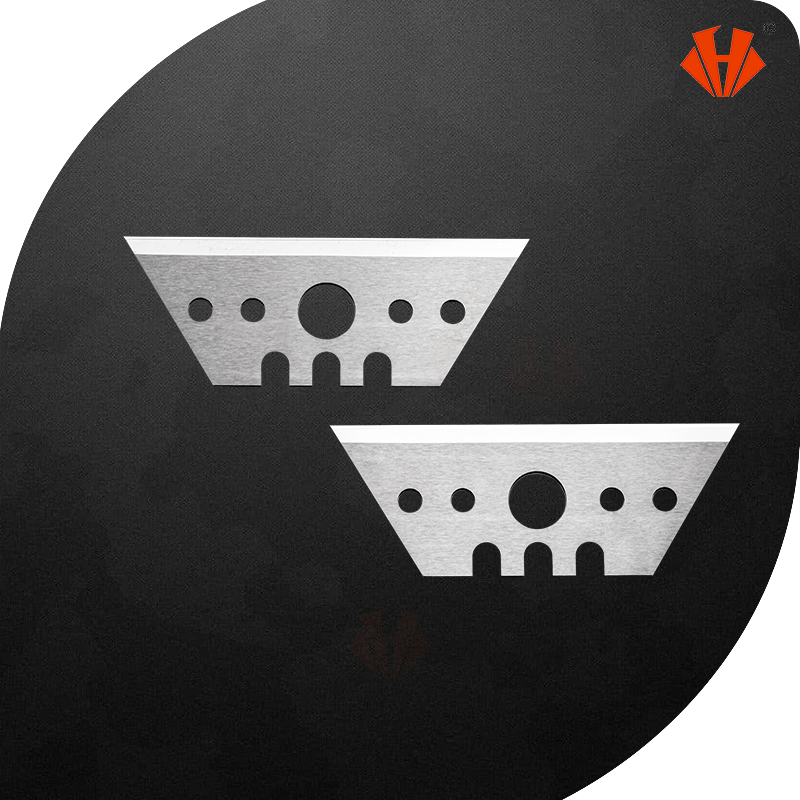Carbide blades are the mainstream choice in the plastic film slitting industry due to their high hardness, wear resistance, and long service life. However, when faced with ever-evolving film materials and increasingly high slitting requirements, they still face a series of severe challenges.
1. Challenges Related to Film Material Characteristics
1. Insufficient Homogeneity of WC-Co Powder
Gumming / Resin Build-up:
When slitting certain types of plastic films (such as PVC, EVA, films containing plasticizers, or films that melt easily upon heating), molten residues from the film or statically charged debris can gradually adhere to the blade's cutting edge.
This forms a "built-up edge," leading to rough cutting edges, causing stringing, burrs, or even longitudinal streaks and scratches on the film. In severe cases, the dislodged built-up edge can contaminate the film and the machinery.

Film Sensitivity and Toughness:
Modern films are developing to be thinner and tougher (e.g., high-end packaging films, lithium battery separator films). They are very "delicate" and extremely sensitive to the sharpness of the cutting edge. Even slight microscopic blunting of the edge can prevent a "clean" cut, resulting instead in "tearing" or "crushing" the film.
The slit edge develops whiskers or burrs resembling "butterfly wings," or the film stretches and deforms at the slit point, affecting the smoothness of subsequent winding.
Material Diversity:
There is a wide variety of plastic films, ranging from soft PE and PP to harder PET and PI, and from pure unfilled materials to composite films containing fillers like calcium carbonate, talc, or glass fibers. Different materials have completely different requirements for the blade's material, coating, and edge geometry.
A single "universal" blade is difficult to adapt to all materials. When slitting films containing fillers, these fillers act as high-strength abrasives, drastically accelerating blade wear.
2. Challenges Related to the Blade's Own Performance
Cutting Edge Sharpness Retention:
Although carbide blades have high hardness, the microscopic sharpness of the initial edge (often measured by the cutting edge radius) may not match that of high-end steel. More importantly, maintaining this ultimate sharpness over long periods of high-speed slitting is the biggest technical challenge.
Edge blunting is the primary cause of declining slitting quality. To restore sharpness, blades need to be frequently removed for regrinding, leading to increased downtime and reduced production efficiency.
Micro-chipping of the Cutting Edge:
The nature of cemented carbide is sintering of metal powders like tungsten and cobalt, resulting in relatively poor toughness. During slitting, if encounters film splices, impurities, or sudden tension changes occur, the brittle cutting edge is prone to microscopic chipping.
A single tiny chip can leave a continuous defect on the slit film edge, causing the entire roll to become substandard.

Challenges in Coating Technology:
To improve wear resistance and anti-adhesion properties, blades are often coated (e.g., with DLC - Diamond-Like Carbon, TiN - Titanium Nitride, etc.). However, the adhesion strength, uniformity of the coating, and how to maintain edge sharpness after coating are critical.
Coating delamination or unevenness not only fails to provide protection but the detached coating particles can scratch the film surface.
III. Edge Processing and Coating Challenges
3. Challenges Related to Slitting Process and Application
Heat Management at High Speeds:
Modern slitting lines operate at increasingly higher speeds. The intense friction between the blade and the film generates significant heat. If this heat is not dissipated promptly, the blade temperature rises.
High temperatures can soften the coating or the substrate of the blade, accelerating wear; it can also cause local melting of the film, exacerbating the gumming phenomenon.
Choice of Slitting Method:
Shear Slitting (or Knife-to-Knife): The upper and lower blades cut by direct engagement. This requires extremely high precision in blade installation and concentricity. Slight misalignment or run-out can cause rapid edge chipping.
Razor Slitting (or Down-Edge): The blade cuts on an anvil roll. The contact and wear between the blade edge and the anvil roll is also a balancing issue. Insufficient pressure won't cut through, while excessive pressure wears both the blade and the anvil roll.
Cost Pressure:
High-quality carbide slitting blades are expensive. For film producers, blades represent a significant consumable cost.
A detailed economic calculation is required, balancing the initial purchase cost of the blade, its service life, the number of regrinds possible, and the scrap rate caused by blade-related issues.
2. Addressing These Challenges

Upgrading Tool Material and Coating Technology:
Use finer-grained, even ultra-fine grained carbide substrates to improve toughness and sharpness.
Developing and applying nano-composite coatings (e.g., nc-AlTiN) with lower friction coefficients, higher hardness, and thermal stability.
Precision Edge Preparation and Geometry Design:
Applying edge honing (creating a microscopic rounded edge) via processes like laser processing or brushing to reduce the risk of micro-chipping while maintaining macroscopic sharpness.
Customizing the optimal edge geometry (such as rake angle, relief angle) based on the material being slit.
Strict Process Control and System Matching:
Ensuring the precision of the slitting equipment (e.g., rigidity and run-out of the blade holder).
Optimizing slitting parameters (e.g., tension, speed, overlap).
Using high-quality anvil rolls (or sleeves).
Professional Maintenance and Regrinding Services:
Establishing standardized procedures for blade use, cleaning, and maintenance.
Choosing professional regrinding services to ensure each regrind restores the blade's original geometric accuracy and sharpness, rather than simply making it "sharp again."
About Huaxin:Tungsten Carbide Cemented Slitting Knives Manufacturer
CHENGDU HUAXIN CEMENTED CARBIDE CO.,LTD are a professional supplier and manufacturer of tungsten carbide products, such as carbide insert knives for woodworking,carbide circular knives for tobacco&cigarette filter rods slitting,round knives for corugatted cardboard slitting ,three hole razor blades/slotted blades for packaging ,tape,thin film cutting,fiber cutter blades for textile industry etc.
With over 25 years development, our products have been exported to U. S. A, Russia, South America,India,Turkey,Pakistan,Australia,Southeast Asia etc. With excellent quality and competitive prices, Our hard working attitude and responsiveness are approved by our customers. And we would like to establish new business relationships with new customers.
Contact us today and you will enjoy benefits of good quality and services from our products!
The high performance tungsten carbide industrial blades products
Custom Service
Huaxin Cemented Carbide manufactures custom tungsten carbide blades, altered standard and standard blanks and preforms, starting from powder through finished ground blanks. Our comprehensive selection of grades and our manufacturing process consistently delivers high-performance, reliable near-net shaped tools that address specialized customer application challenges across diverse industries.
Tailored Solutions for Every Industry
custom-engineered blades
Leading manufacturer of industrial blades
Customer common questions and Huaxin answers
That depends on the quantity, generally 5-14days. As an industrial blades manufacturer, Huaxin Cement Carbide plans the production by orders and customers' requests.
Usually 3-6 weeks, if you request customized machine knives or industrial blades that are not in stock at the time of purchasing. Find Sollex Purchase & Delivery Conditions here.
if you request customized machine knives or industrial blades that are not in stock at the time of purchasing. Find Sollex Purchase & Delivery Conditions here.
Usually T/T, Western Union...deposits firstm, All first orders from new customers are prepaid. Further orders can be paid by invoice...contact us to know more
Yes, contact us, Industrial knives are available in a variety of forms, including top dished, bottom circular knives, serrated / toothed knives, circular perforating knives, straight knives, guillotine knives, pointed tip knives, rectangular razor blades, and trapezoidal blades.
To help you get the best blade, Huaxin Cement Carbide may give you several sample blades to test in production. For cutting and converting flexible materials like plastic film, foil, vinyl, paper, and others, we provide converting blades including slotted slitter blades and razor blades with three slots. Send us a query if you're interested in machine blades, and we'll provide you with an offer. Samples for custom-made knives are not available but you are most welcome to order the minimum order quantity.
There are many ways that will prolong the longevity and shelf life of your industrial knives and blades in stock. contact us to know about how proper packaging of machine knives, storage conditions, humidity and air temperature, and additional coatings will protect your knives and maintain their cutting performance.
Post time: Sep-24-2025












